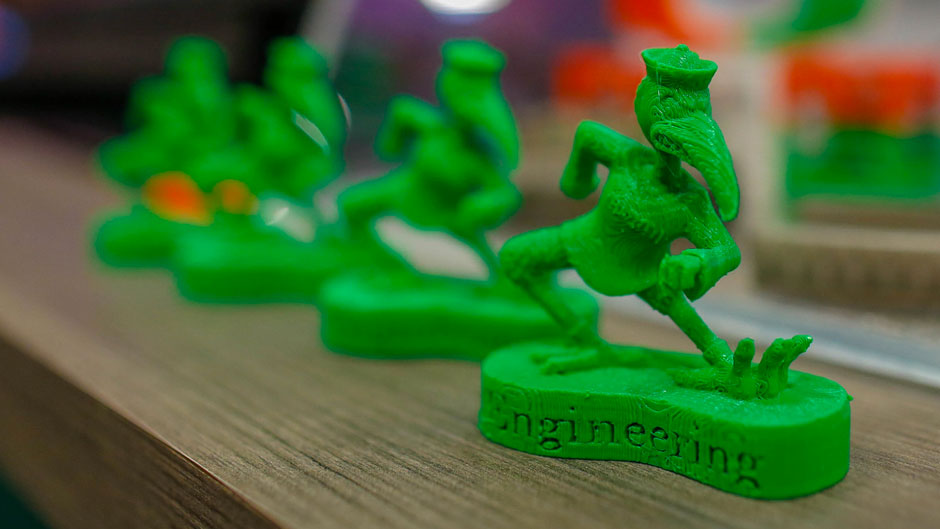Lena Gonzalez pulls the space age-looking pair of goggles over her eyes, looks directly ahead, and begins moving her hands in the air to manipulate a series of data-laden windows that appear before her on a flat-screen display, moving one of the windows from the bottom of the screen to the top and whisking another completely out of view.
Her gestures recall a scene from the movie Minority Report, in which actor Tom Cruise, working in a high-tech crime lab, views a murder by using his hands to shuffle images on a translucent screen.
In Gonzalez’s case, however, this isn’t Hollywood but the real thing. The first-year graduate student in the University of Miami School of Communication’s Cinema and Interactive Media Department is part of a team of students designing an augmented reality (AR) helmet for NASA that will allow astronauts to perform tasks in space by superimposing graphics over a real-world environment.
A version of the helmet—called the NASA Spacesuit User Interface Technologies for Students project, or SUITS—was just one of the cutting-edge UM innovations on display Monday at the University’s exhibition space at eMerge Americas—the two-day technology conference at the Miami Beach Convention Center that connects innovators, investors and thought leaders through workshops, talks, networking and high-tech demonstrations.
“Cool stuff,” said Stervens Pauleus, an employee with UM’s Parking and Transportation department, as he experimented with the goggles.
“And just imagine where astronauts could use them. On a space walk from the International Space Station, or, what would really be amazing, on a trip to another planet,” said Gonzalez, beaming over the prospect that the goggles could one day be aboard a manned mission to Mars.
At the School of Nursing and Health Studies’ eMerge booth, augmented reality of a different sort was on display as Super Tory, a lifelike infant simulator moved its arms and legs, blinked, cried, cooed, and exhibited a range of medical conditions, from respiratory distress to cardiac arrest. “We can even change its color and slow its heart rate and other vital signs,” said Susana Barroso-Fernandez, assistant professor of clinical and director of simulation operations at the nursing school.
Last September, the school opened its five-story, 41,000-square-foot Simulation Hospital, which replicates all aspects of a fully functioning healthcare system with features such as a home health care suite, operating rooms, a surgical and intensive care suite, and a neonatal intensive care unit for patients like Super Tory.
“Students can learn from their mistakes without putting patients at risk,” said Barroso-Fernandez, noting that Super Tory is one of many patient simulators the school has.
More than a thousand people die in the U.S. every day from medical errors, making it the third leading cause of death in the nation. “Simulation technology is designed to break that cycle,” said Barroso-Fernandez, a former pediatric intensive care nurse who practiced CPR on static mannequins, administered IVs on partial-task trainers, and injected oranges with hypodermic needles when she was a student nurse in training.
Today, simulation in the medical field is widespread. But it’s not the end-all for training technology. “Virtual reality is where we’re going next,” said Barroso-Fernandez. “We already have a space for it in the new Simulation Hospital.”
Such immersive learning is one of the best ways to acquire knowledge, UM President Julio Frenk said at the Future of Leadership and Fostering Entrepreneurship eMerge keynote on Monday. He noted UM’s opening of its Simulation Hospital and commented that “the future of Miami lies in innovation.” Also on Monday, Jeffrey L. Duerk, executive vice president for academic affairs and provost, and Brian Breslin, the new director of the Launch Pad at UM, participated in the panel, The Tipping Point, examining what it takes for an entrepreneurship ecosystem of ideas and companies to not only live, but also thrive.
High-tech sensor technology was on display at the School of Architecture’s eMerge exhibit. “Normally, sensors are thought of as invisible and passive, collecting data and sending it to a survey which is then analyzed,” said Christopher Chung, research associate at the school’s RAD-UM lab. “But there’s a need for a subset of sensors that interact and visualize data at the point of collection.”
A sensor that displays a sad face when noise levels in a particular area are too loud or shows a happy face when it is quiet; a sensor that records sound bites, collecting data on the buzz of the hour; and a sensor that records UV levels, warning people about the risks of unprotected exposure to the sun are among the types of sensors on which RAD-UM is collaborating with the Center for Computational Science (CCS).
One sensor, developed by CCS research associate Shijia Geng, is already deployed on the sixth floor of UM’s Gables One Tower, recording traffic and pedestrian flow along a busy section of US 1.
But it was a so-called robotic cloud, a helium-inflated parasol guided by a drone, that Chung was most excited about. “We can cluster 50 to 100 of them in a public space to create a large area of shade, and at night they can serve as lighting devices,” he said, noting they have been proposed for an area north of Miami’s Wynwood district.
Two 3D printers produced miniature replicas of UM mascot Sebastian the Ibis at the exhibit staffed by personnel from the College of Engineering-Johnson & Johnson 3D Printing Center of Excellence Collaborative Laboratory. Dedicated late last year, the facility will soon take delivery of a new micro 3D printer capable of producing delicate medical surgical devices such as those used in laparoscopic procedures, according to Troy Thompson, director of facilities at the college.
eMerge Americas continues Tuesday with more panels, demonstrations and networking.

